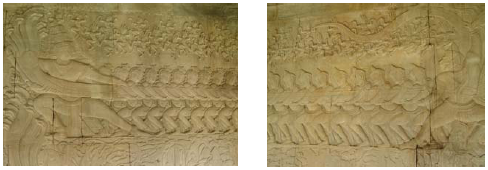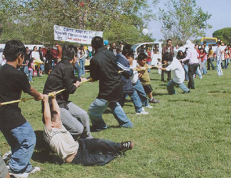Teagn Prot is a tug-of-war game with teams of boys and girls pitting their strengths by pulling on the rope. Teagn Prot has a number of significant stories in Khmer culture as seen in the folktales below. Its hidden meanings extend into historical and religious realms.
One upon a time there was a group of giants who felt that the angels did have more power than them but the angels were more powerful because the Siva (supreme divine being) blessed the angels with power. The team of giants boasted that the angels would lose in a competition of strength. As the angels heard that, they replied that they were not afraid. The giants and the angels agreed to pit their strengths against one another in a tug-of-war competition. If the giant won, the giants will receive higher status by sitting in a higher location than the angels including those times they met with Siva.
The angels were walking back and forth in front of Siva's courtyard trying to figure out a sure way to win the competition when Pealy - the King of the monkey who was aware of the competition - told them of a trick that guaranteed victory.
The next day, the competition between the angels and giants begin. The rope used in the competition was the serpent. The angels requested to have the head side of the serpent and the giants agreed. The angles used the trick mentioned by Pealy which is to have one angel use his finger to rub the belly button of serpent. As the serpent is tickled it swings its tail back and forth loosening the grips of the giants at the tail-end. The angels won the tug-of-war.
There is a proof of this competition in the Angkor Wat bas-relief depicting the serpent stretched along the wall with the angels holding the head side and the giants holding the tail side.

The giants and angels came together to stir and dry out the ocean to get the elixir of life so that they could live forever. They used a serpent named Vasuki as the rope to move and turn Montakrak Mountain. Vishnu, a powerful god, turned himself into a turtle to prop up the mountain. The angels pulled at the head of the serpent while the giants pulled at the tail. When turning, the serpent got dizzy and threw up the balk poison and breathed fire through its tongue. This creates rain in the celestial sphere.
This game requires a 30 feet rope the size of a small wrist and a noise making tool such as a drum to signal the start of the game.
You divide the players into two teams of at least 5 to 10 people per team. This is usually the girls vs. guys. Each team does not necessary have the same number of people but rather depends on size and strength. The rule of the thumb is to have at least 2 more people on the girl's team than the guy's team. The suggested arrangement is to use the strongest people at the end of the robe and at the front of each team. [PHE04T]
On the rope, mark the center by tying a color knot. The rope is laid in a straight line and each team will take one side about 5 feet passed the center mark.
To start, the person with the drum stands in the center between the two teams and yells "Yeak Orr" ( ) with a long drawn-out manner. Then the teams will yell "Ho Vueyyy" (
) in a similar style. This is repeated three times then the drum beats the signal for the teams to start pulling. As the game starts, the drummer can continue to beat to assist the teams. [PHE04T]
When a team is pulled over where the color knot passes the marked line, the other team wins the game.

This game probably has a hidden meaning relating to rain worship. In the top folktale, the serpent represents the rain. In India, the serpent is the bridge to connect people to the gods and is also symbolized by the rainbow. The rainbow is the entity that sucks in the water to create rain. Thus pulling the rope in the Teagn Preat game is like pulling the serpent to make rain and is also known as the rain-making ceremony. [PHE04T]